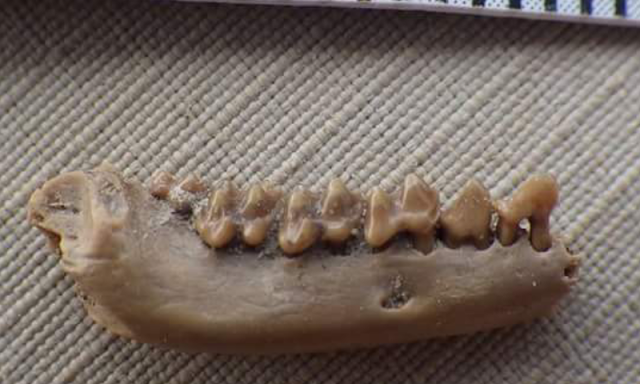At first, NDSU senior Sean Ternes didn’t realize he had an incredible find at his fingertips. But he soon learned the small fossil he discovered in the dust of the North Dakota Badlands dates back to the time of the dinosaurs.
Ternes, a geology major, is an intern this summer for the North Dakota Geological Survey. Most days, he prepares data about sandstone formations in the Bakken region.
Another of his internship duties is to teach proper fossil-hunting techniques to volunteers who participate in the agency’s annual series of public digs. And that’s what he was doing July 9 about 2 p.m. near Bowman, North Dakota.
“I was walking around, looking for exposed fossils on the surface,” Ternes said. “I came around the corner, noticed something and got down on my knees to take a closer look.”
Ternes stumbled upon a pile of modern bones, possibly from a rabbit. But, just a foot away, another small bone caught his eye.
“My first thought was that it was from the modern mammal that had died, but it had a little discoloration; it had a darker color to it,” Ternes said, noting he carefully brushed away the soil from around the bone and leaned in to examine it.
The fossil, just over an inch long, was the jawbone of a Glasbius twitchelli, a small marsupial that lived near at the end of the Cretaceous Period about 65 million years ago. The small creature was among the first mammals on earth, appearing shortly before the dinosaurs became extinct.
Ternes speculates the jawbone was only recently unearthed by water or wind erosion, because the fossil was in superb condition. The entire lower jaw was intact, with six tiny teeth still in place.
“I showed it to one of the survey paleontologists and he got very, very excited. Then, I knew I had found something pretty important,” said Ternes, who grew up in Bismarck, North Dakota. “My thought was ‘Wow’ and that’s when I got excited.”
Fossils of Glasbius twitchelli have been found in Montana and Wyoming, but never as far east as North Dakota.
“Finding a complete mammal jaw from the Late Cretaceous is very rare, and the specimen Sean found may be the most complete lower jaw ever found for this species,” explained Clint Boyd, North Dakota Geological Survey senior paleontologist. “This find improves our knowledge of this species and enhances our understanding of the Late Cretaceous fauna from North Dakota.”
Paleontology is an interesting subject for Ternes, but it’s not his life’s calling. He plans a career in economic geology after graduate school. “Mineral exploration is my real passion. I want to eventually look for potential gold, silver or copper mines,” he said.
“Finding the fossil, though, was cool.”
The jawbone is now in North Dakota Geological Survey’s State Fossil Collection.
Note: The above post is reprinted from materials provided by North Dakota State University.











